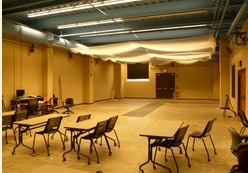Health and Exercise Sciences Department
Piper Movement Analysis Lab
Located in the Health Sciences Building, the Fontaine Piper Movement Analysis Laboratory is used by students and faculty for class activities and research involving the study of how the human body moves and acquires new motor skills through the perspectives of biomechanics and motor learning.
Biomechanics is the study of the anatomical and mechanical aspects of human movement. Human movement is created through muscle and joint motion. The equipment used in lab allows the evaluation of these movements with the ultimate purpose of finding a more effective way to perform them. For most lab activities several pieces of equipment are used simultaneously to provide data concerning the mechanical and neuromechanical aspects of motion. For example, to evaluate a vertical jump researchers could use:
- Vicon Nexus 3D Motion Capture system
- Delsys Trigno Wireless EMG
- Bertec Mounted Force Plates
The Delsys Trigno Wireless EMG system allows the measurement of muscle activity when completing the jump, a valuable neuromechanical measure. When these three systems are used in unison, researchers can determine what aspects of motion affect vertical jump height. Researchers could determine the joint angles of individuals with relatively high vertical jumps.
Other biomechanics equipment used in the lab includes:
- portable Kistler force plate
- Dartfish software
- timing lights/pads
- goniometers
Motor learning is based on various principles of psychology and neurophysiology that address the factors which influence the acquisition and subsequent performance of movements. In the Piper Lab, the focus is on studying how neurophysiology affects movement. Neurophysiology involves the brain and other sensory systems throughout the body. For this reason the goal of the motor learning equipment is to isolate a sensory system so that it can be determined what effect that system has on movement. For example, while the biomechanical analysis of a vertical jump provides information about the execution of the movement, the motor learning approach would address how a novice athlete may acquire the desired movement and/or the changes in the muscle activation patterns (as measured through the EMG system).
Additionally, researchers can attach Techno Concept Vibrators, neuromuscular vibrators that modify the proprioceptive sensory system thus inhibiting its ability to assist people in movement. In analyzing a vertical jump these would be attached to the muscles primarily used during a vertical jump and height of vertical jumps would be measured with and without the Techno Concept Vibrators being activated. If the jump heights were different between times when the Techno Concept Vibrators were activated and when they were not, it would indicate that the proprioceptive sensory system has an effect on vertical jump height.
The Neurocom Balance Analyzer provides information on an individual’s balance using weight distribution while immobile or throughout a movement. This equipment could be used to analyze if an individual’s ability to shift their weight back and forth affects peak vertical jump height. For instance, if a participant has a more even weight distribution during takeoff and impact of a vertical jump, will he or she have a relatively lower vertical jump height? Other equipment in the lab concerning motor learning includes: anticipation/reaction timers, perception/vision displacement goggles, kinesthesiometers, and depth perception boxes.
The Fontaine Piper Movement Analysis Laboratory is used for the study of how the human body performs a wide variety of movements. Additionally, most of the equipment is portable – allowing students and faculty to explore research questions outside the laboratory when appropriate.

